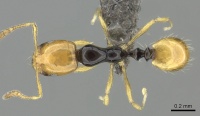Monomorium mirandum
| Monomorium mirandum | |
|---|---|

| |
| Scientific classification | |
| Kingdom: | Animalia |
| Phylum: | Arthropoda |
| Class: | Insecta |
| Order: | Hymenoptera |
| Family: | Formicidae |
| Subfamily: | Myrmicinae |
| Tribe: | Solenopsidini |
| Genus: | Monomorium |
| Species: | M. mirandum |
| Binomial name | |
| Monomorium mirandum Arnold, 1955 | |
Known from various forest and open forest habitats.
Identification
Bolton (1987) - A member of the M. altinode complex in the M. monomorium species group. The very distinctive colour pattern of mirandum renders it immediately identifiable among the Afrotropical Monomorium fauna. The species belongs to the altinode-complex and the structure of its petiole and postpetiole indicates that it is closest related to the Ghanaian Monomorium vonatu. The latter is uniformly black in colour and has much shorter scapes (SI 83).
Keys including this Species
Distribution
Latitudinal Distribution Pattern
Latitudinal Range: -4.303694° to -18.952948°.
| North Temperate |
North Subtropical |
Tropical | South Subtropical |
South Temperate |
- Source: AntMaps
Distribution based on Regional Taxon Lists
Afrotropical Region: Kenya (type locality), United Republic of Tanzania.
Distribution based on AntMaps
Distribution based on AntWeb specimens
Check data from AntWeb
Countries Occupied
| Number of countries occupied by this species based on AntWiki Regional Taxon Lists. In general, fewer countries occupied indicates a narrower range, while more countries indicates a more widespread species. |

|
Estimated Abundance
| Relative abundance based on number of AntMaps records per species (this species within the purple bar). Fewer records (to the left) indicates a less abundant/encountered species while more records (to the right) indicates more abundant/encountered species. |

|
Biology
Castes
Worker
Images from AntWeb
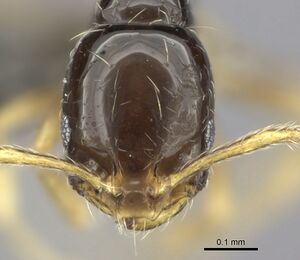 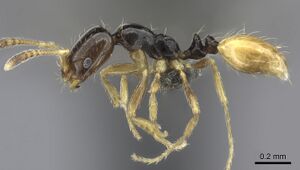 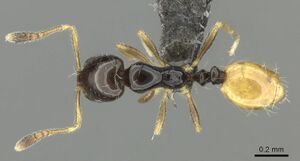 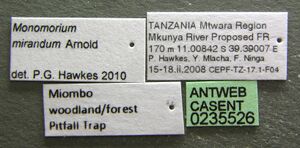
| |
| Worker. Specimen code casent0235526. Photographer Will Ericson, uploaded by California Academy of Sciences. | Owned by AFRC, Pretoria, South Africa. |
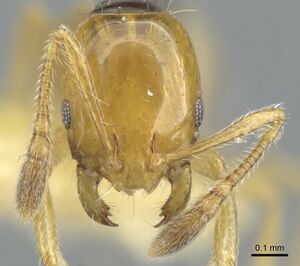 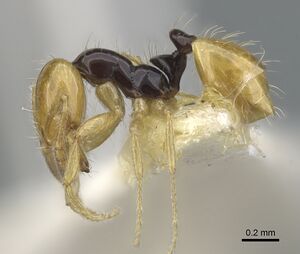 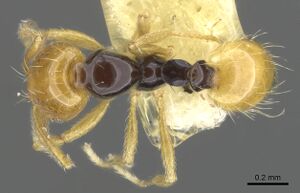 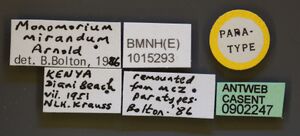
| |
| Paratype of Monomorium mirandum. Worker. Specimen code casent0902247. Photographer Will Ericson, uploaded by California Academy of Sciences. | Owned by NHMUK, London, UK. |
Nomenclature
The following information is derived from Barry Bolton's Online Catalogue of the Ants of the World.
- mirandum. Monomorium (Monomorium) mirandum Arnold, 1955: 734, fig. 2 (w.) KENYA.
- Type-material: syntype workers (number not stated, “a small series”).
- Type-locality: Kenya: Diani Beach, vii.1951 (N.L.H. Krauss).
- Type-depositories: MCZC, SAMC .
- Status as species: Ettershank, 1966: 90; Bolton, 1987: 401 (redescription); Bolton, 1995b: 264; Hita Garcia, et al. 2013: 212.
- Distribution: Kenya.
Unless otherwise noted the text for the remainder of this section is reported from the publication that includes the original description.
Description
Worker
Bolton (1987) - TL 1.8-1.9, HL 0.50-0.52, HW 0.38-0.39, CI 74-76, SL 0.38, SI 97-100, PW 0.26, AL 0.50-0.54 (3 measured).
Clypeal carinae conspicuous, widely separated and divergent anteriorly, terminating at the anterior clypeal margin in a pair of short but quite broad triangular denticles. Prominent median portion of clypeus with its margin transverse between the denticles, the latter distinctly separating the anterior and lateral margins. Maximum diameter of eye 0.21-0.23 x HW and with 6 ommatidia in the longest row. With the head in full-face view the posterior margins of the eyes distinctly in front of the mid length of the sides of the head. Antennal scapes, when laid straight back from their insertions, just failing to reach the occipital margin; the latter shallowly concave. Promesonotal dorsum evenly convex in profile, conspicuously higher than the propodeum. Metanotal groove broadly impressed but metanotal cross-ribs very short, scarcely longer than the width of the minute pinhole-like propodeal spiracle. Propodeal dorsum highest immediately behind the metanotal groove , the surface then sloping posteriorly, feebly convex and rounding broadly and evenly into the declivity. Peduncle of petiole narrow, its ventral process reduced to an insignificant short ridge. Node of petiole high and narrow, triangular and tapering to a narrowly rounded point dorsally. Anterior and posterior faces of petiole node meeting in a sharp rim or edge, which is continuous around the sides and dorsum. Node of postpetiole very high and narrow, almost as high as petiole, tapering dorsally but more broadly rounded than the petiole node. Anterior face of postpetiole vertical, and laterally with the anterior and posterior faces meeting in a rim or edge, but this does not continue across the dorsum. All dorsal surfaces of head and body with standing hairs present, the promesonotum with 5-6 pairs. Sculpture absent except for scattered hair-pits and the short metanotal cross-ribs. Spectacularly bicoloured species. Head and its appendages, legs, and gaster bright yellow; alitrunk petiole and postpetiole blackish brown to black.
Type Material
Bolton (1987) - Syntype workers, Kenya: Diani Beach , vii . 1951 (N. L. H. Krauss) (Museum of Comparative Zoology) [examined].
References
- Bolton, B. 1987. A review of the Solenopsis genus-group and revision of Afrotropical Monomorium Mayr (Hymenoptera: Formicidae). Bulletin of the British Museum (Natural History). Entomology. 54: 263-452.. (page 734, fig. 2 worker described)
- Bolton, B. 1987. A review of the Solenopsis genus-group and revision of Afrotropical Monomorium Mayr (Hymenoptera: Formicidae). Bull. Br. Mus. (Nat. Hist.) Entomol. 54: 263-452 (page 401, see also)
References based on Global Ant Biodiversity Informatics
- Arnold G. 1955. New species of African Hymenoptera. No. 11. Occasional Papers of the National Museum of Southern Rhodesia. 2: 733-762.
- Bolton B. 1987. A review of the Solenopsis genus-group and revision of Afrotropical Monomorium Mayr (Hymenoptera: Formicidae). Bulletin of the British Museum (Natural History). Entomology 54: 263-452.
- Ettershank G. 1966. A generic revision of the world Myrmicinae related to Solenopsis and Pheidologeton (Hymenoptera: Formicidae). Aust. J. Zool. 14: 73-171.
- IZIKO South Africa Museum Collection

